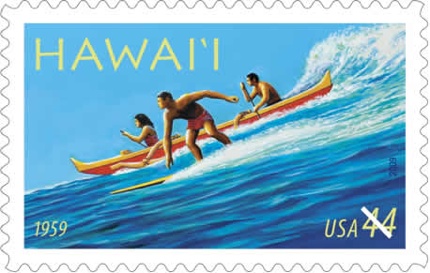The United States Postal Service helped celebrate the 50th anniversary of Hawai’i statehood with a brand new surfing stamp that was desinged by Herb Kawainui Kane (no relation to Rick).
“We’re proud to play a part in this significant anniversary for Hawai‘i and especially proud that the stamp will serve as a lasting reminder of this special occasion,” said U.S. Postal Service Honolulu District Manager Daryl Ishizaki in dedicating the 44-cent First-Class stamp that goes on sale nationwide today. . . Joining Ishizaki in dedicating the stamp was Hawai‘i Governor Linda Lingle.
The 44-cent First-Class stamp that goes on sale nationwide today. Follow the jump for the rest of the story.
Hawai‘i Statehood Stamp Extends First-Class ‘Wave of Excitement’
Local Historian, Artist, Created Stamp Image
HONOLULU — Surf’s up! The U.S. Postal Service celebrated the 50th anniversary of Hawai‘i statehood by dedicating the Hawai‘i Statehood stamp today.
“We’re proud to play a part in this significant anniversary for Hawai‘i and especially proud that the stamp will serve as a lasting reminder of this special occasion,” said U.S. Postal Service Honolulu District Manager Daryl Ishizaki in dedicating the 44-cent First-Class stamp that goes on sale nationwide today.
Joining Ishizaki in dedicating the stamp was Hawai‘i Governor Linda Lingle.
The event took place at the state’s official Commemoration Conference at the Hawai‘i Convention Center.
Stamp artist and historian Herb Kawainui Kane of Captain Cook, HI, who dedicated much of his life to studying Hawaiian culture and history, created the stamp image. Kane worked under the direction of stamp designer Phil Jordan of Falls Church, VA. In the art, a surfer rides a wave on a longboard, a popular choice among surfers for centuries. Next to him, two people paddle an outrigger canoe to shore. Kane has extensive knowledge and experience in surfing, a favorite pastime, and in canoe construction, a skill he developed from building a traditional sailing canoe himself.
Hawai‘i Background
About 1,500 years ago, Polynesians settled the islands that now make up the state of Hawai‘i. A few hundred years later, a group of Tahitians arrived on the shores and created a rich and thriving culture based on stewardship of the abundant resources provided by the land and sea.
Captain James Cook from England arrived in 1778 and named the islands after the Earl of Sandwich. A year later, Cook was killed in a dispute with the natives, but was followed by many more foreign ships traveling to the islands. The British influence is still seen today through the Union Jack symbol represented on the state flag, and streets and parks named after early British individuals and events. In 1810, King Kamehameha I united the islands of Hawai‘i under a monarchical government, and for much of the 1800s, the world regarded Hawai‘i as an independent nation. In 1893, a small group of mostly non-Hawaiian citizens and foreigners overthrew the reign of Queen Lili‘uokalani and formed a provisional government.
Annexed by the U.S. in 1898, the islands became the Territory of Hawai‘i in 1900. The Japanese attack on the U.S. military at Pearl Harbor, on Dec. 7, 1941, brought thousands more Americans to the islands to participate in the war effort, and many remained when World War II ended. On August 21, 1959, President Dwight D. Eisenhower signed a proclamation that officially welcomed Hawai‘i into the United States.
The “Aloha State” is made up of eight main islands and more than a hundred smaller ones, all formed by volcanic activity. The island of Hawai‘i continues to grow in size with every eruption of Kilauea, the most active volcano in the world. The capital and largest city, Honolulu, is located on the island of O‘ahu and is the center of transportation and business for the islands. O‘ahu is home to nearly 900,000 people out of state’s 1.2 million total population.
The geographical features of each island help create a wide range of climates. Some areas experience significant rainfall, while others are dry and desert-like. Temperatures are mild and consistent across the islands. With sandy beaches, fertile valleys, and stunning volcanic mountains, Hawai‘i is a tropical paradise.
In Hawai‘i there is no ethnic majority; the population includes Native Hawaiians, Caucasians, Japanese, other Pacific Islanders, Filipinos, Chinese, Vietnamese, Koreans and many others. Hawai‘i is a bilingual state. After a steep decline in the use of Hawaiian language in the early 1900s, Hawaiians started to revive their language and culture in the 1970s. Hawaiians have the utmost respect for their ‘ohana (extended family), land, cultural traditions and ancestors.
With more than seven million visitors traveling to the islands annually, tourism drives the Hawaiian economy. The islands offer a serene vacation environment and a wide array of activities. Surfing was a favorite sport in Hawai‘i long before Captain Cook’s arrival, and it remains highly popular today. In addition to tourism, the state’s economy is heavily based on diversified agriculture, including pineapples, macadamia nuts and flowers.
